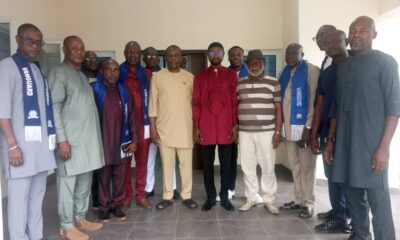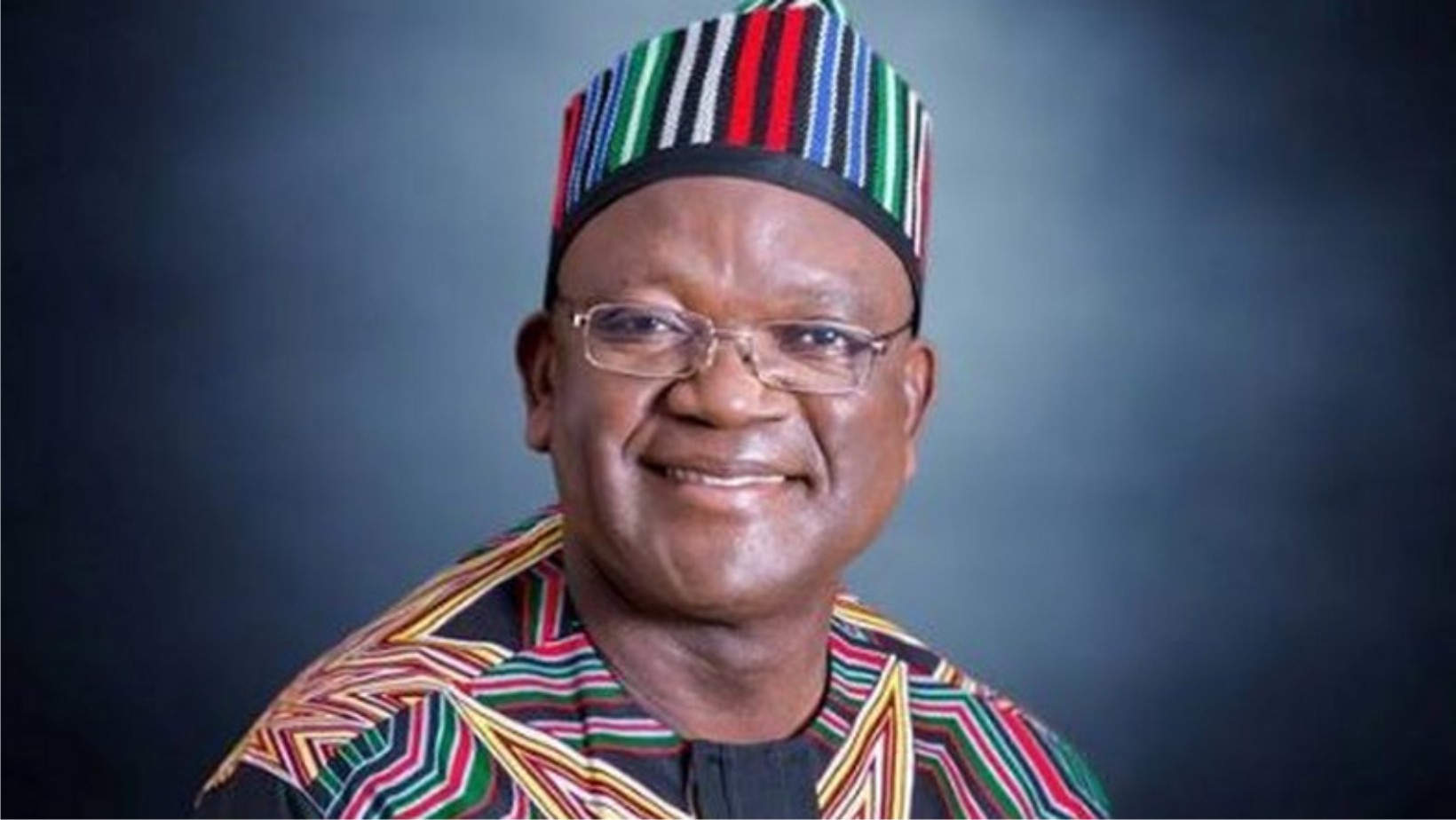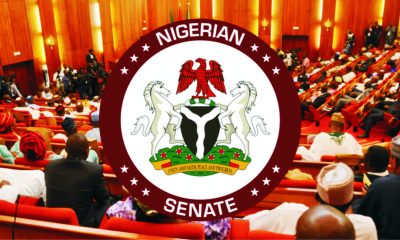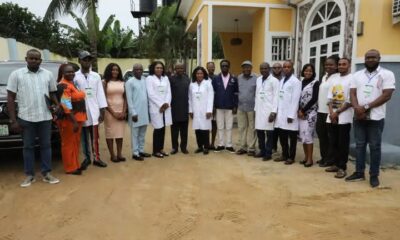Arts/Literary
Nigeria At 50: A Generational Statement Arts Review
Nigeria is indeed a country of heterogeneous ideas and visions. This explains the reason behind the cacophony of voices that trail the humongous N10 billion, now reduced to N6.5 billion, budgetted for Nigeria’s 50th independence anniversary. While many Nigerians rail at the amount, some others see the commemmoration of the nation’s golden jubilee as a long-awaited opportunity to celebrate Nigeria’s 50 years of political independence, and square with some other African countries like Ghana, Senegal and Cameroun.
The Thought Pyramid Art Gallery owned by Jeff Ajueshi is one of those who share the optimistic view. In preparation for this, it has assembled a variety of captivating art works from seasoned artists to project Nigeria’s image in visual representation to the whole world. The art centre located in Wuse 11 Abuja recently held an exhibition of the art works which captured some of the political and socio-economic happenings in Nigeria since independence.
Mufu Onifade, one of the 50 exhibiting artists takes a look at the one -week event which took place in Abuja last week. The exhibition cannot be better described than a generational statement. He writes:
From now till the end of the year and probably beyond, various artistic nay cultural celebrations would bubble up the space, at various venues across the country. But more importantly, the visual art sub-sector is expected to chronicle the country’s social, economic and political experiences in visual form; and this is one of the thrusts of the exhibiting show titled Generational Statement. This long-awaited 50th anniversary of independent nationhood exudes a multitude of celebrations, which cuts accross all strata of the society. As a nation of multi-cultural diversity and surplus natural resources, Nigeria is reputed to be practically flowing with milk and honey. These are visible in some of the creations packaged ready for public consmption.
Since 1960 when she got her independence from colonial masters, Nigeria has constantly and delicately operated as a nation in transition, even among the comity of other nations. Her post-colonial period has brought on her people from various shades of inconsequential imbroglio ranging from politics to enonomics.
The civil war, the recurrent coups and counter-coups, the internal strife and different shades of struggles among her people of many nationalities are characteristic of experiences culminated in the modern day nascent democracy. Such experiences visually recorded in various media were on display.
In view of prevailing circumstances, the visual art sub-sector, which has been constantly constrained to the lower ebb of food chain, has, within the purview of robust cultural development, provided unequalled succour to both the nation and her numerous immigrants and visitors. The richness of Nigeria’s aesthetic legacies is re-embossed in the variety and diversity of creative outputs engendered by flourishing generations of Nigerian artists.
Ever since Aina Onabolu, the doyen of Nigerian art took the bull by the horn and transplanted visual arts into the school curriculum in Nigeria, academic training has combined effectively with informal training to produce a profoundly rich sub-sector. By extension, various generations from that era through to the era of the modernist artist, Ben Enwonwu to this contemporary times, have engraved their impressions on the artistic sand of time.
That the Thought Pyramid Art Gallery, Abuja founded and run by its curator, Jeff Ajueshi, has generously assembled an astonishing variety of art works from seasoned practitioners for a commemorative exhibition titled Generational Statement is a bold statement on the volume of creative products on the Nigeria’s creatively fertile soil.
As Ajueshi proudly, but succinctly puts it, this one-of-its-kind show “ parades accomplished artists whose works are capable of telling the story of Nigeria from different perspectives of themes, mediums and aesthetics”. These works, as he explains further, are captured in exquisite paintings and sculptures rendered in an array of mediums and concepts. The exhibition also addressed “recreation, pre, post, and neo-post freedom of the Nigerian essence” while not losing sight of attracting expressive visual art forms and scholarly critique and commentaries on Nigerian art.
Bruce Onobrakpeya, in recognition of his masterful antecedence and historical relevance to contemporary Nigerian art, was selected as Guest Artist for the show. His catalystic approach to art development is more than enough qualification to play this noble role in the midst of other 50 exhibiting artists including Ben Osawe, Sam Ovraiti, Duke Asidere, Bob Aiwerioba, Enotie Ogbebor, Sam Ebohon and Mufu Onifade. Others are Donald Onuoha, Ogaga Tuodeinye, Rotimi Akinere, Tony Enebeli, Toni Oshiame, Ayodeji Agboola, Nelson Edewor, Raji Olanrewaju, Ajibade Awoyemi, Ola Balogun, Suraju Adekola, Stanley Dudu, Chukz Okonkwo,Tolu Aliki, Emmanuel Dudu, Ada Godspower, Olumide Oresegun, Klara Nze, lyke Okeyin , Uche Onyishi, Francis Umoh and Stanley Agbontaen.
Chinedu Onuigbo, Moses Zibor, Nelson Okoh, Frank Beli, Joe Essien, Tyna Adebowale, Prosper Akeni, Emmanuel Ozugwo, Babalola Lawson and lke Francis also joined Chike Obieagu, Bob Nosa Uwagboe, George Edozie, Victoria Udoidian, Olufemi Kayo, Oyerinde Olotu, Oviri Aleric, Uche Uzorka, Aldophus Opara, Tom Sater and Godswill Ayemoba to make the show padded with unassuming creativity. These artists are representative of a cross section of generations of contemporary Nigerian artists and their diverse works speak volume about the Nigerian identity in visual form.
Thought Pyramid is one of the few galleries holding the forte in a credible manner in Abuja. It is named after the iconic postulations of one of Nigeria’s political giants, Mallam Aminu Kano whose composite image in the country’s socio-political consciousness, “his unblinking patriotism, his positive iconoclacism, his enlightenment and fervent desire for a strong, united and prosperous nation, through ventilation of progressive and execution of ideals for a respectable visibility in the comity of nations”, are reminiscent of his unequalled legacies.
According to Ajueshi, “At the Thought Pyramid Art Gallery, these qualities and aspirations (for the nation) are shared with the late great patriot”. As a gallery in the promotion of visual arts and culture and the inalienable magic mirror of the sector, the Thought Pyramid goes further to serve as a public space for the singular vision and creativity of thinking heads that create the arts.
As an art centre with untainted world class consciousness, it tells the stories through research, documentation and publication, while, in practical terms, promoting art through exhibitions and providing marketing opportunities within a space conducive for art collectors to comfortably view and acquire rare art works from the nation’s capital city.
All efforts are geared towards the promotion of Nigerian art and culture and one hereby hopes that as Nigeria prepares for her 50th independence anniversary, all these aspirations and operations will, on the long run, rub off on Generational Statement as an avenue to positively project Nigeria’s image in visual representation to the world at large.
Social/Kiddies
Need For Girl-Child Education In Society
Girl-child education is a way by which a girl- child is being exposed through formal education for proper education.
It is a process whereby a girl-child is being exposed to some certain things according to “teachmit@wp”.
Girl-child education refers to the aspect of education that ends at developing the skills and knowledge of girls and women no matter their backgrounds.
Some parents think that educating a girl- child is wasting of their resources. No. When a female child is educated, it gives her that respect even the husband cannot treat her anyhow because he will know her worth.
The importance of educating the girl- child cannot be overemphasised. It helps to empower the country and makes them have a better life. Once they are educated, they realise the importance of exhibiting good hygiene habits.
It may interest you to know that when a girl-child is educated, she has a sense of belonging in the society. In Nigeria nowadays, they have the potential of becoming governors, chairmen of local government areas, among others.
The tendency of taking cognisance of the importance of reduction in child bearing is high. When a woman is educated, the level in which she will give birth will reduce considering the dangers inherent.
Firstly, she will calculate herself and know when to conceive, although with the consent of her husband and the numbers of children she wants.
A girl who is educated will know how to educate her children properly. She will be of good benefits to the family.
Truly, a girl who is not properly educated will suffer lack of knowledge, fall into early marriage which will lead into early pregnancy. Some of these can cause domestic violence.
Women need education because without proper knowledge, a woman cannot run her home properly. A woman that is educated leads her home aright.
Some men use and take advantage of uneducated women by rendering all kinds of abuses on them, some rape their wives in course of making love and others insults their wives in public all because there is no education. In life, males and females should be educated without discrimination.
Furthermore, educating a girl-child is like investing in a big business that one will not run into a loss.
According to Dr Shaifali, girls’ education is like sowing the seed which gives rise to a revitalised, cheerful and full-grown family plants.
She also said educated women have the capacity to bring socio- economic changes.
Growing up from the family of three, my father told me that he was not ready to train a female child and when I asked why, he said: ” because when you will grow and become great, then, a man will come from nowhere and marry you and all my money will be wasted. When you marry, your name will be changed that means all your riches and wealth will become your husband’s own because you people are one”.
Frankly, I was very bitter with myself and I started questioning God that why was I not created as man, but I took it upon myself that weather the devil likes it or not, I will prove my father wrong by going to school and I will show the difference.
As parents when training children we should not think less of any child because every child is important and have value.
Every child is a blessing from God. This is a clarion call to all men of our present society to accord their wives the respect they deserve. A man can develop his wife after marriage.
Education plays an important role in the life of a girl-child. Let every girl-child be educated. The government should provide the society with basic amenities such as good schools that are well-equipped.
Parents from time to time should be re-oriented in this regard taking cognisance of the importance of developing the girl-child. None should be misled by saying that the girl-child need not attend formal education.
Since some parents do not have the wherewithal to sponsor their children, governments at all levels should introduce free education to give room for equal opportunity. Bursary payment should be re-introduced in all higher educational institutions.
Education is the bedrock of any society therefore women education cannot end in the kitchen.
Princess Npapa
Princess Npapa is a student of Pan Africa Institute of Management and Technology.
Social/Kiddies
Celebrating Woman As An Icon Of Strength
A woman is a dynamic multifaceted individual who embodies resilience, courage and determination.
She is a game changer and a force to be reckon with, a confidant empowered, supportive, adaptable and inspirational.
Many had asked why women are being celebrated even as recorded in calendar so frequently unlike men and I said, a woman being multifaceted and embodies resilience and determination is worth being celebrated unlike in the 80s when women were meant to understand that their place was in the kitchen of their husbands’ houses.
What an amazing level of development where women can choose a career and work on themselves and know that there is more to life than being in the kitchen and ending up in a man’s house with nothing to show for it.
Women are the strongest versions of the gender of humans in the world even in their silence, women hold a depth of emotions, questions and unspoken thoughts. Their smiles often conceal their true feelings, masking their fears, doubts and desires.
Despite these challenges, women continue to rise above, shattering glass ceilings and pushing boundaries.
Today innovative, women are enterprenuers, leaders, and change agents. Inspiring women like Ngozi Okonjo-Iweala, Chimamanda Adichie and many others have paved the way for future generation, their achievements serve as testaments to women’s strength, resilience and capabilities.
The calendar tell us how unique the woman is and her significance in the home and society at large. As a woman, she holds power and I celebrate every woman out there in the world irrespective of how you may have fallen, you shall rise above the challenges, support one another and celebrate collective strength and resilience.
Woman as an icon of strength is not just about individual achievements but creating supportive networks, uplifting others and celebrating collective success, defying expectations and redefining what it means to be a strong woman.
The strength and bravery of women are worthy of celebration by the entire world as none is unique as the epitome of nation builders, character molders and pacesetters not just in their family but to the society at large.
A woman is a selfless mother, lover and care giver to her family, a daughter who supports her parents, as a sister’s unshakeable bond with her siblings and a friends unconditional empathy and understanding.
These acts of kindness and love are not most times talked about but hold families and communities together and bonding strong women are powerful beings who have impacted the society, shaping the foundation of the world from the 80s to date, I personally want to celebrate all the icons of strength who had fought and are still fighting , that our voices as women are heard even unto the ends of time.
I celebrate you all amazing women for standing strong and paving ways for the future generation for equality, justice and human rights. To the rising child, teenager and adults who happen to be a ‘woman’, I celebrate our collective efforts, our strength in helping one another to rise, irrespective of our differences in our backgrounds.
We are super humans, unique beings, no wonder the Bible acknowledges the importance of our strength. Therefore, let’s celebrate every woman out there.
Kate Chisom Isiocha
Isiocha, is a student of Temple Gate Polytechnic.
Social/Kiddies
Children And Basics Of Family
It is the idea of God that family should exit. Children form part of the family. God loves family so much that Jesus was born into the family of Joseph.
Everyone’s family is good and important. Children should not look down on their family whether they are rich or poor.
Children should respect and honour their family and foster love among their siblings. They should work together and make peace in the family. They should always stand in the gap. It is good for family members to carry all along since everyone may not be doing well.
The Christianity that children learn is practised in family. Faith-based organisations do a great job in moulding children’s character. Those are the behaviours that children exhibit towards siblings in family.
Every child born in a family is there for a purpose. A baby born into a family is supplying something. It may be joy, wealth and so on. Everyone is important in a family.
Adolescents who have graduated from school but may not be contributing financially can do one or two things at home. You can engage in preparing meals at home while parents are away for a job or business. Contributing in house chores will go a long way to relieve parents of stress after a day’s job.
What do you contribute to your family, especially during holidays both in nuclear and extended family?
The family you were born is constant but friends are temporary. You can decide not to continue in friendship but you cannot cut off your family. No matter how bad you think your family is and you decide to leave home, you must surely return. Your friends can harbour you for a while.
The child’s first identity comes from the family. What the child learns first comes from the family.
Family is the centre of love and care. People have started playing down on marriage because of neglect on basics of family. Marriage starts today and and the next few months, it is threatened. Respect for family plays a crucial role in marriage.
No child grows without parental control and influence. If a child refuses to grow without taking instructions from parents, he may grow up being wild. There are consequences when children do not obey their parents. There are those who want to be rebellious against their parents. They should know that their length of days are tied to their parents.
Your bioligical parents know you more than every other person. There is the wisdom and knowledge your parents have that you do not so it is proper to listen to them before choosing carriers both in academics and job. A young man or woman can choose who to get married to, but a greater role in the choice of who to marry and the marriage proper comes from the parents.
They know what is best for you. No matter how modern trends will influence you and prove it wrong, parent is the key. No one can love you more than your parents because they are your blood.
A lot of parents have been traumatised due to the fact that children they nurtured and trained turned their back on them at older age. Children should not abandon their parents for any reason.
As you grow up, situations may arise in marriage when you decide it is over with your spouse, but no matter the level of provocation with your parents, they will not despise you. Parents will also play a role in that regard. Problem arises in every family but how it is handled matters a lot.
Some children honour their mentors more than their parents. Although there are parents who shy away from their responsibilities. It is important that parents take full responsibility of their children. You cannot bring a child to the planet earth and refuse to perform roles as a parent. But parents may not quantify what they spent from childhood to adolescence. That is a blessing children cannot get from another person.
There are people who have attributed their failure in life to the fact that their parents, especially mothers are witchcraft. It is wrong to feel that your mother is instrumental to your failure in life. The only way to success is hardwork.
Let money not determine the level of love for your parents. Wherever a child goes, family is constant.
Eunice Choko-Kayode
-
Opinion1 day ago
Is Nigeria Democratic Nation?
-

 News1 day ago
News1 day agoI’m Committed To Community Dev – Ajinwo
-

 News1 day ago
News1 day ago2027: I Stand With Southern Presidency -Ortom
-
Rivers1 day ago
HOS Tasks Rural Dwellers On RAAMP … As Project Sensitization Team Visit Degema, AKULGA
-

 News1 day ago
News1 day agoSenate Replaces Natasha As Committee Chairman
-
Opinion1 day ago
Checking Herdsmen Rampage
-

 Niger Delta1 day ago
Niger Delta1 day agoHYPREP Trains Lab Technicians To Standardise Water Quality In Ogoniland
-
News1 day ago
Tinubu, Govs Forum Congratulate Okpebholo On S’Court Victory …As Obaseki Expresses Disappointment

